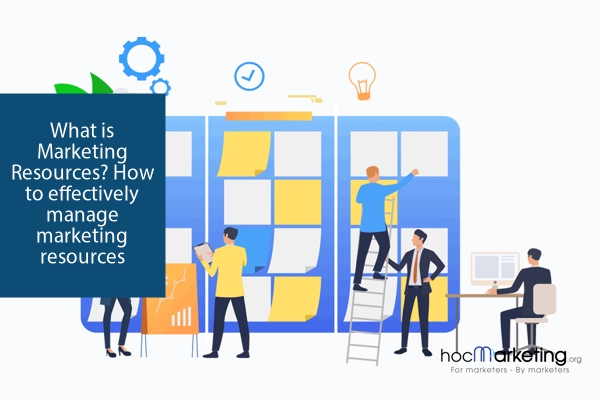
The Ultimate Guide to Understanding Resource Management: Types, Differences, and Importance

Resource management is crucial in ensuring optimal utilization of available resources It involves scheduling, planning, and allocating resources to achieve maximum efficiency With the right techniques and best practices, organizations can make informed decisions and create effective resource management plans that yield numerous advantages
Definition
Resource management is the process of scheduling, pre-planning and allocating your existing resources to maximize efficiency.
A project or task requires various resources to be executed successfully. These could include the skills of the employees involved or the proficiency level of the software being used. When organizing a meeting, for instance, resources needed might entail scheduling staff attendance, defining the meeting agenda, and ensuring that necessary materials such as presentation screens, laptops, and project reports are available.
1. Maximization of resource efficiency
Maximizing the potential of available resources is the fundamental concept behind resource utilization. This refers to the proportion of time that resources are actively engaged in tasks or operations within a designated period. Evaluating resource utilization is crucial in determining whether your resources are functioning at optimal levels.
Proper utilization planning is crucial when managing both your team and its resources. This becomes especially important when resources are tasked with multiple projects simultaneously. By effectively planning for utilization, you can gain insight into resource availability and make informed decisions about which tasks are best suited for which individuals on your team.
Overbooking or under booking can result in negative consequences. When individuals face more challenges, they tend to feel more fulfilled and motivated in their job. This implies that teams should be pushed to achieve higher levels of productivity. On the other hand, excessive workload and overuse of resources can lead to burnout. Research has demonstrated that implementing management practices that enhance job control can reduce the likelihood of burnout.
Utilization can serve as a valuable tool for managing both human and nonhuman resources. Beyond simply tracking employee productivity, it can also be used to monitor the efficiency of machinery and identify potential downtime issues. By taking a long-term approach to planning, utilization data can help businesses proactively address problems before they become more serious. For instance, if a particular machine is expected to undergo heavy use, utilization metrics can inform decisions around repair and replacement timelines. Ultimately, this level of visibility enables organizations to take both a microscopic and macroscopic view of their projects, optimizing performance and minimizing disruptions.
Effective resource management is crucial for successful project management, especially when dealing with multiple projects and resources across different locations. By implementing a divide and conquer approach, you can gain an overview of all the resources involved and manage each aspect of the project accordingly. This level of control allows for a more efficient and organized management process.
Ensure that you review the overall resource plan to ensure that all components are properly aligned. In project management, it is crucial to have a comprehensive understanding of all elements involved, as this enables you to determine what needs to be accomplished and by when.
Having an overview of the project also enables you to track progress and manage your team more effectively, providing you with greater visibility and keeping you informed of any developments. Additionally, it allows you to assess the efficiency of your team and resources, enabling you to make more accurate predictions for future projects. This level of control is essential for conquering all necessary tasks.
By utilizing resource management, all resources, including personnel, can easily access their assigned tasks. This provides project managers with the ability to monitor the allocation of resources, ensuring transparency in the planning process. As a result, miscommunication mishaps can be prevented.
An open process of resource management is crucial for both theoretical and practical reasons. Inevitably, misunderstandings arise, particularly in companies where multiple project managers schedule resources with a single central point for live updates. Overbooking of resources and frequent task status changes are common occurrences. The resulting long list of emails and missing important information can lead to communication chaos with stakeholders. It's impossible to know when the result sheet will be sent and if it contains accurate, up-to-date information. Implementing resource management fosters transparency and helps avoid such misunderstandings.
Increased transparency is highly valued by both companies and employees alike. When transparency is prioritized, employee engagement tends to improve. This, in turn, can foster a sense of team spirit and commitment to both the job and the company. Additionally, transparency can help foster trust among stakeholders, as they are able to see what is happening within the organization. To achieve this degree of transparency, it is important to utilize tools that allow for controlled access by all team members.
Fragment 12:
By implementing transparency through central resource management tools, potential miscommunication mishaps between managers, clients, and team members can be avoided. Moreover, this approach keeps everyone updated, enhancing overall efficiency. This tool also enables controlled access to information for all team members, thereby creating a sense of accountability. Ultimately, this benefits the entire company, as transparency helps to foresee potential problems and avoid them.
When it comes to managing and planning a project, it's crucial to have a clear understanding of the timeline and the resources required to make it happen. By predicting the necessary tasks and resources ahead of time, you can effectively plan for any potential challenges or roadblocks that may arise.
Resource planning is key to ensuring that your project runs smoothly. This involves understanding how resources are allocated and utilized, from client meetings and equipment bookings to incoming shipments and budget management. By staying connected with project managers and regularly checking resource availability, you can ensure that everything is being utilized to its fullest potential.
Effective planning is crucial for any project. It allows for flexibility in case of changes, and helps identify potential bottlenecks. By anticipating overlapping vacations, holidays, maintenance schedules, and trainings, you can better prepare for any disruptions. Additionally, long-term planning enables you to make necessary adjustments in advance, ensuring a smoother project flow. Taking the time to organize and plan resources early on can prevent problems from escalating, allowing you to focus on other important tasks and ultimately lead to a more successful project outcome.
Correct decisions
Proper monitoring and control of ongoing projects is a crucial responsibility of the project manager. Keeping track of the progress of resources is essential to ensure successful completion of projects. This task can only be accomplished with the aid of appropriate tools, which are indispensable for effective management. To recognize the significance of resource allocation and planning, there are numerous tools available, ranging from simple spreadsheets to more sophisticated software solutions. By planning and managing resources, project managers can gain insights into the allocation of tasks and timelines, thus enabling them to optimize team member productivity.
By monitoring downtime, you can identify individuals who can be reassigned to support other tasks. Additionally, assessing the availability of personnel, equipment, and other resources is crucial to determining whether additional resources need to be brought in to complete the job successfully. Planning resource management is an ongoing process that allows for a comprehensive understanding of the entire operation, and tracking resource performance metrics helps with accurate forecasting.
This will help you to select the best alternative for your company and your project. It will also help you to avoid running into frequent problems and save precious time.
Creating a Resource Management plan
To effectively plan a project, it's important to list all resources such as people, materials, and equipment. The next step is determining how many of these resources are needed to complete the project and creating a schedule for their utilization.
Having a comprehensive list of all the resources needed for the project is crucial in resource planning. This includes not only machinery and personnel, but also the number of rooms required in the office and the space needed to accommodate all the resources. It is important to dedicate ample time to creating this list as a more thorough and accurate list will result in a more effective schedule.
Ensure that you have a clear and detailed plan for each resource, including the amount needed and when it will be needed. By quantifying your resources on a daily basis and integrating them into a monthly schedule, you can ensure that you have everything you need at the right time.
Once you have determined the resources needed, it is essential to estimate the number of hours required for the project. It is crucial to quantify each resource and its corresponding hours needed to ensure that the project stays on track. Additionally, it is important to identify both assumptions and constraints as they directly impact project planning. Accurate constraints must be separated from assumptions, which may or may not be true. Allocating an ample amount of hours per resource not only aids in the timely completion of the project but also assists other teams and their leaders in planning their own projects accordingly.
Techniques
Utilizing resources effectively is key to maximizing their potential. By identifying the skills and capacities of your team members, you can allocate resources in a way that optimizes project outcomes. This process involves utilizing existing resources in the most efficient manner possible.
Resource allocation reports offer managers a comprehensive view of resource allocation, ranging from high-level to detailed views. These reports enable managers to avoid schedule delays and stay within budget. The more advanced reporting capabilities at your disposal, the greater control you have over your project.
Resource levelling is a valuable resource management technique that can identify underutilized or inefficiently used resources within a company and optimize their utilization.
A content writer with graphic design experience can aid the design team by taking on smaller content tasks that require design work, thus exemplifying resource leveling in action. If the team member can adapt their design skills, the design team may not need to outsource work to freelancers in the event of last-minute design requests.
Having a resource management plan in place is crucial for maximizing the use of materials, personnel, and budget. By utilizing resource forecasting techniques, you can anticipate future resource needs well in advance of project initiation.
Knowing the resources needed for a project is crucial in determining its scope and potential challenges, as well as any unforeseen costs that may arise. Project managers should have a solid understanding of the project's objectives and life cycle in order to accurately forecast resource needs. Utilizing project management software can provide a centralized location for accessing all project resources and data, improving overall visibility and organization.
Advantages
By comprehending all of your available resources, you can anticipate and prevent any unexpected hindrances. This enables you to strategize and allocate them effectively, allowing you to mitigate any potential issues before they occur.
By managing resources effectively, you can prevent employee burnout and avoid over-dependence on specific resources and locations. Additionally, resource planning provides a safety net in case a project does not succeed, allowing you to demonstrate that you took all necessary steps to achieve success.
By implementing resource management, teams can establish clear communication channels and foster a more transparent work environment. This transparency builds trust among team members and with the company as a whole.
Moreover, resource management allows for a more accurate measurement of efficiency. With a detailed understanding of the necessary resources required for project execution, teams can optimize their workflow and ensure successful project completion.
Best practises
To optimize your resource utilization, it's important to recognize which resources are in short supply. The Pareto principle suggests that 20% of the resources will be in high demand by 80% of your team. By prioritizing these resources, you can plan more effectively to prevent bottlenecks and delays.
Instead of relying on conventional approaches to prioritize work, it's better to establish an evaluation process that facilitates decision-making and avoids potential problems. Monitoring unplanned work is crucial, as it can drain resources and cause delays in project timelines. Different types of work within the organization may require specific methods and tools to achieve maximum efficiency and alignment. By utilizing traditional methodologies over collaborative work, your company can effectively manage, deliver, and plan projects.
Resource management is an ongoing process that involves dealing with inevitable changes. It is essential to collaborate and tackle all downstream and immediate priorities together.
The process of planning, managing, and reporting does not have to consume all your time, nor does it require an equal amount of time. Finding a balance that suits each situation is crucial. Streamlining your reporting process can help ensure that it doesn't become a time-consuming task.
Efficient planning is key when it comes to managing projects. It's important to take into account the start and end dates as well as the duration of each task. Aligning projects with other tasks can lead to strategic outcomes. Utilizing automated processes whenever possible can also help to reduce administrative tasks and improve efficiency.
















